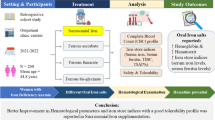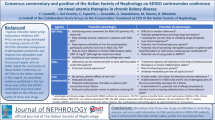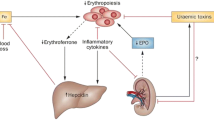Abstract
The glutathione redox system, haemoglobin (Hb) oxidation, the activity of antioxidant enzymes and the lipid peroxidation product malonyl dialdehyde (MDA) were studied in red blood cells (RBCs) during administration of recombinant human erythropoietin (rhEPO) over 12 weeks in ten children maintained on haemodialysis. A rapid increase in the reticulocyte count was accompanied by a slower rise in total Hb concentration. The mean level of oxidized glutathione (GSSG) increased from 13.2±5.3 nmol/g Hb to 56.7±15.8 nmol/g Hb 4 weeks after the start of rhEPO (P<0.001), followed by a fall to the basal value. Reduced glutathione (GSH) levels showed a smaller though constant elevation during rhEPO therapy (P<0.001). Before rhEPO treatment, incubation of RBCs for 1 h with acetylphenylhydrazine induced a decrease in GSH concentration compared with controls (P<0.001), which became more pronounced in the first few weeks of rhEPO therapy (P<0.001). In addition, the percentage of Hb derivatives (metHb and haemichrome) increased in the first 4 weeks of rhEPO therapy (P<0.001). Although there was no significant difference between the values obtained preEPO and during EPO treatment, MDA levels were continuously higher and superoxide dismutase, catalase and glutathione peroxidase concentrations were lower than in the controls (P<0.001). These results are compatible with oxidative damage to the RBCs in the early period of rhEPO therapy in children with end-stage renal failure. The GSH-GSSG system, as an important cellular defence mechanism of the RBCs, appears to be severely affected.
Similar content being viewed by others
References
Giardini O, Taccone-Gallucci M, Lubrano R, Ricciardi-Tenore G, Bandino D, Silvi I, Ruberto U, Casciani CU (1984) Evidence of red blood cell membrane lipid peroxidation in haemodialysis patients. Nephron 36: 235–237
Taccone-Gallucci M, Lubrano R, Belli A, Meloni C, Morosetti M, Maschini L, Elhi M, Boffo V, Pisani F, Giardini O, Casciani U (1989) Disappearance of oxidative damage to red blood cell membranes in uraemic patients following renal transplant. ASAIO Trans 35: 533–535
Túri S, Németh I, Vargha I, Matkovics B, Dobos É (1991) Erythrocyte defence mechanisms against free oxygen radicals in haemodialysed uraemic children. Pediatr Nephrol 5: 179–183
Hörl WH, Riegel W, Steinhauer GH, Wanner C, Thaiss F, Bozkurt F, Haag M, Schollmeyer P (1986) Granulocyte activation during hemodialysis. Clin Nephrol 26: 530–534
El-Rashidy FH, Al-Turk WA, Stohs SJ (1984) Glutathione, glutathione reductase and glutathione S-transferase activities in erythrocytes and lymphocytes in chronic renal disease. Res Commun Chem Pathol Pharmacol 44: 423–430
Seth RK, Saini AS, Aggarwal SK (1985) Glutathione peroxidase activity and reduced glutathione content in crythrocytes of patients with chronic renal failure. Scand J Haematol 35: 201–204
Kishore BK, Gejyo F, Arakawa M (1983) Lipid peroxidation uraemia: malondialdehyde — a putative uraemic toxin. IRCS Med Sci 11: 750–751
Pfafferott C, Neiselman J, Hochstein P (1982) The effect of malonyl dialdehyde on erythrocyte deformability. Blood 59: 12–15
Stocks J, Kemp M, Dormandy T (1971) Increased susceptibility of red blood cell lipids to autooxidation in haemolytic states. Lancet I: 251–266
Esbach JW (1989) The anaemia of chronic renal failure: pathophysiology and the effects of recombinant erythropoietin. Kidney Int 35: 134–148
Walluer SF, Kurnick J, Vautrin R, Ward HP (1977) The effect of the serum of uraemic patients on erythropoietin. Am J Hematol 3: 45–49
Moriyanna Y, Rege AB, Fisher JW (1975) Studies on an inhibitor of erythropoiesis. II. Inhibitor effects of serum from uremic rabbits on heme synthesis in rabbit bone marrow cultures. Proc Soc Exp Biol Med 148: 94–97
Tietze F (1969) Enzymic method for quantitative determination of nanogram amounts of total and oxidized glutathione: application to mammalian blood and other tissues. Anal Biochem 27: 502–522
Akerboom TPM, Sies H (1981) Assay of glutathione, glutathione disulphide and glutathione mixed disulphides in biological samples. Methods Enzymol 77: 373–382
Güntherberg H, Rapaport S (1968) Eine Methode zur Bestimmung des oxydierten Glutathions. Acta Biol Med Ger 20: 559–564
Beutler E (1957) The glutathione instability of drug-sensitive red cells. A new method for the in vitro detection of drug sensitivity. J Lab Clin Med 49: 84–95
Matkovics B, Novák Z, Hoang Duc Hahn, Szabó L, Vargha SzI, Zalesna G (1987) A comparative study on some important experimental animal peroxide metabolism enzymes. Comp Biochem Physiol [B] 56: 31–34
Misra HP, Fridovich I (1972) The role of superoxide anion in the antioxidation of epinephrine and a simple assay for superoxide dismutase. J Biol Chem 247: 3170–3175
Sedlak I, Lindsay RH (1968) Estimation of total protein-bound and nonprotein sulphydryl group in tissue with Ellman's reagent. Anal Biochem 25: 192–205
Chin DTY, Stults FH, Tappal AL (1976) Purification and properties of rat lung soluble glutathione peroxidase. Biochim Biophys Acta 445: 558–566
Placer ZA, Cusman L, Johnson BC (1966) Estimation of product of lipid peroxidation by malonyl dialdehyde in biochemical systems. Anal Biochem 16: 359–364
Lowry OH, Rosebrough NI, Farr AL, Randal RI (1951) Protein measurement with the folin phenol reagents. J Biol Chem 193: 265–275
Akhrem AA, Andreyuk GM, Kisel MA, Kiselev PA (1989) Hemoglobin conversion to hemichrome under the influence of fatty acids. Biochim Biophys Acta 992: 191–194
Szebeni J, Winterbourn CC, Carrell RW (1984) Oxidative interactions between haemoglobin and membrane lipid. A liposome model. Biochem J 220: 685–692
Sobota JT (1989) Recombinant human erythropoietin in patients with anaemia due to end-stage renal disease. US multicenter trials. Contrib Nephrol 76: 166–178
Scigalla P, Bonzel KE, Bulla M, Burghard R, Dippel J, Geisert J, Leumann E, Lilien TV, Müller-Wiefel DE, Offner G, Pistor K, Zoellner K (1989) Therapy of renal anaemia with recombinant human erythropoietin in children with end-stage renal disease. Contrib Nephrol 76: 227–240
Susuki M, Hirasawa Y, Hirashima K, Arakawa M, Odaka M, Ogura Y, Yoshivama Y, Sanaka T, Shinoda A, Morii H (1989) Dose-finding, double-blind, clinical trial of recombinant human erythropoietin (Chugai) in Japanese patients with end-stage renal disease. Contrib Nephrol 76: 179–192
Offner G, Hoyer PF, Latta Winkler L, Brodehl J, Scigalla P (1990) One year's experience with recombinant erythropoietin in children undergoing continuous ambulatory or cycling peritoneal dialysis. Pediatr Nephrol 4: 512–514
Esbach JW, Egrie JC, Downing RM, Browne JK, Adamson JW (1987) Correction of the anaemia of end-stage renal disease with recombinant human erythropoietin. N Engl J Med 316: 73–77
Nielsen OJ, Thaysen JH (1989) Response to erythropoietin in anaemic haemodialysis patients. J Intern Med 226: 89–94
Sinai-Trieman L, Salusky IB, Fine RN (1989) Use of subcutaneous recombinant human erythropoietin in children undergoing continuous cycling peritoneal dialysis. J Pediatr 114: 550–554
Schaefer RM, Kürner B, Zech M, Krahn R, Heidland A (1988) Therapie der renalen Anämie mit rekombinanten humanen Erythropoietin. Dtsch Med Wochenschr 113: 125–129
Bommer J, Alexion C, Müller-Bühl J (1988) Recombinant human erythropoietin therapy in haemodialysis patients. Dose determination and clinical experience. Nephrol Dial Transplant 2: 238–242
Srivastava SK, Beutler E (1969) The transport of oxidized glutathione from human erythrocytes. J Biol Chem 10: 9–16
Costagliola C, Romano L, Sorice P, Di Benedetto A (1989) Anaemia and chronic renal failure: the possible role of the oxidative state of glutathione. Nephron 52: 11–14
McCord J, Fridovich I (1969) Superoxide dismutase. An enzyme function for erythropoietin. J Biol Chem 244: 6049–6055
Eaton JW, Boraas M, Etkin NL (1972) Catalase activity and red cell metabolism. In: Brewer GJ (ed) Proceedings of the Second International Conference on Red Cell Metabolism and Function. Plenum, New York, pp 121–131
Vanella A, Geremia E, Tiriolo P, Giglio A, Tiriolo C, Vanella G, Ruggieri G (1981) Scavenger effect of alpha-mercatoproprionglycine on superoxide anion. IRCS Med Sci Biochem 9: 1124–1125
Janero DR (1990) Malondialdehyde and thiobarbituric acid-reactivity as diagnostic indices of lipid peroxidation and peroxidative tissue injury. Free Radic Biol Med 9: 515–540
Anderson KE, Goeger DE, Carson RW, Lee S-M K, Stead RB (1990) Erythropoietin for the treatment of porphyria cutanea tarda in a patient on longterm hemodialysis. N Engl J Med 322: 315–317
Kawabata T, Ogino T, Awai M (1988) Protective effects of glutathione against lipid peroxidation in chronically iron-loaded mice. Biochim Biophys Acta 1004: 89–84
Author information
Authors and Affiliations
Rights and permissions
About this article
Cite this article
Túri, S., Németh, I., Varga, I. et al. The effect of erythropoietin on the cellular defence mechanism of red blood cells in children with chronic renal failure. Pediatr Nephrol 6, 536–541 (1992). https://doi.org/10.1007/BF00866497
Received:
Revised:
Accepted:
Issue Date:
DOI: https://doi.org/10.1007/BF00866497




